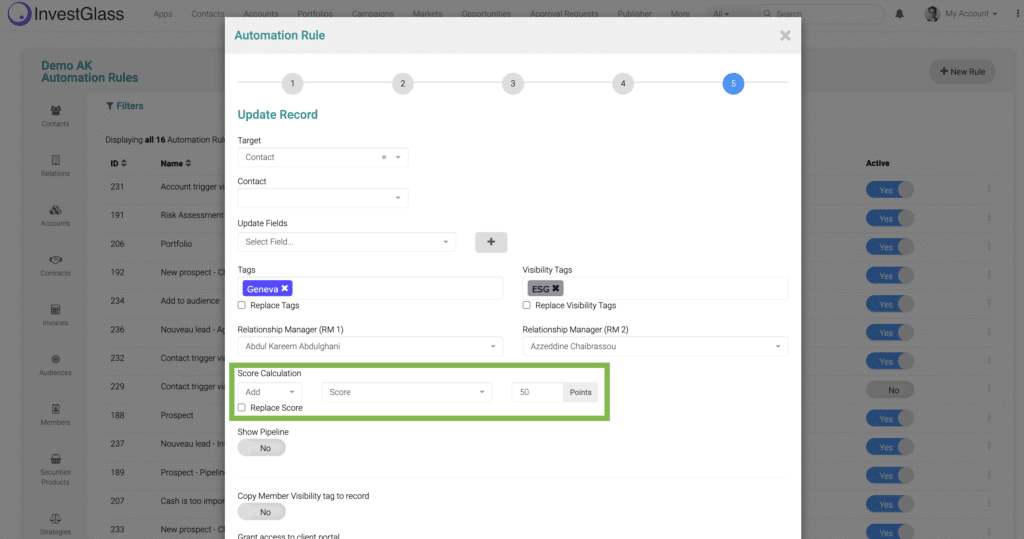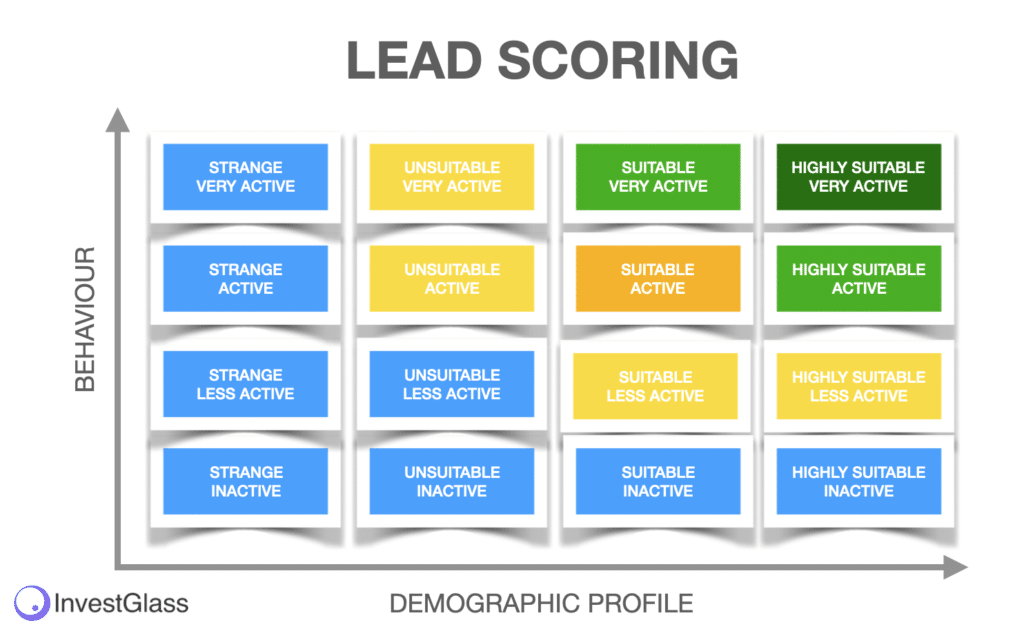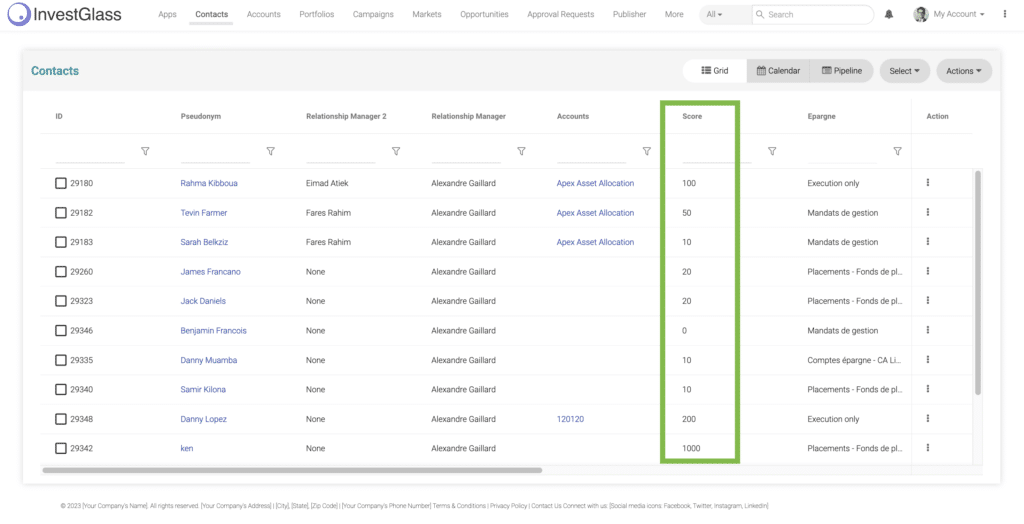The 4 Best Lead Scoring Models in 2023

In today’s cutthroat business environment, maximizing your marketing and sales efforts is essential. One potent strategy is leveraging a lead scoring model, a methodology to rank prospects based on their perceived value to your organization. This blog will delve into the best lead scoring models in 2023, examples included.
What are Lead Scoring Models?
Lead scoring models are strategic tools used by marketing and sales teams to assign points to a lead based on various criteria, resulting in a lead’s score. This score aids sales and marketing teams in distinguishing hot leads from cold ones. The scoring criteria can include a lead’s job title, the company size, interactions with the company’s pricing page, among other revealing data points. InvestGlass automation are used actively to route leads. The filters inside the automation tool will help to evaluate leads dynamically.

There are various lead scoring models in use, some of the common ones include demographic, behavioral, predictive, and collaborative. Each model has its own lead scoring formula, which adds or subtracts point values based on the criteria set by the sales and marketing teams. Negative scoring, for instance, is a process where points are subtracted if a lead performs an action indicating they may not be a good fit, thus giving them a negative score. On the flip side, positive actions result in a higher lead score.
For example, in a demographic lead scoring model, the marketing team could assign numerical values based on a lead’s job title, company size, or industry. A behavioral model, on the other hand, scores leads based on actions like email opens, website visits, or downloading a white paper.
What is the Lead Scoring Algorithm?
The lead scoring algorithm forms the backbone of the lead scoring process. It is the lead scoring formula used to assign point values to various actions and characteristics, which are then combined to get the final lead score. The lead scores can be built in one or two dimensions. All the leads can be relevant leads but you should find a way to match “the fit” with the “behaviour”.
In an explicit scoring system, for instance, sales teams assign point values based on observable, explicit data such as the information provided by the lead or the lead’s company size. Implicit scoring refers to assigning points based on the lead’s actions, like downloading content or visiting the pricing page. Each algorithm integrates both implicit and explicit scoring to calculate the final score.
Predictive lead scoring, a sophisticated lead scoring algorithm, uses machine learning to predict a lead’s likelihood to convert based on past leads’ data. This predictive lead scoring model offers a more nuanced understanding of leads and allows the sales team to focus on the best leads.
Evaluating a Lead Scoring Model and lead scoring process
Evaluating a lead scoring model involves checking its effectiveness in identifying the most qualified leads. This is often done by reviewing the model’s ability to separate hot leads from cold ones, thus assisting sales reps in prioritizing leads that are most likely to convert.
For instance, a lead scoring model that results in too many or too few marketing-qualified leads may need to be recalibrated. Similarly, a scoring model might require adjustments if the sales team finds that leads with high scores are not converting or if leads with lower scores are consistently becoming customers.
Furthermore, the sales cycle’s length can indicate the effectiveness of the lead scoring model. If the model helps to shorten the sales cycle, it’s likely working well. Conversely, if the sales cycle is too long or deals are frequently falling through, it might be time to revisit your lead scoring strategy.
It is interesting to follow this score with smart process to simplify the task fo the relationship managers. Based on a task InvestGlass calendar and email system can send to your prospects emails, SMS with a direct agenda of the relationship manager. This coupling of forms, automation and email is the best way to efficiently manage lead nurturning.
The 4 Best Lead Scoring Models in 2023
- Demographic Scoring: This model is about scoring leads based on demographic data such as job title, company size, location, and industry. Assigning point values to these factors helps you focus on leads that fit your target audience.
- Behavioral Scoring: Behavioral scoring assigns points based on a lead’s behavior or engagement with your company. This could include website visits, social media engagement, email interaction, and content downloads.
- Predictive Scoring: Predictive lead scoring uses machine learning to analyze a vast number of data points from past customer behaviors and trends. It predicts which leads are most likely to convert, enabling marketing and sales teams to focus their efforts on these high-potential leads.
- Collaborative Scoring: This model combines demographic and behavioral data with insights from your sales team, leading to a more rounded scoring model. It allows your sales and marketing teams to work collaboratively in scoring leads.
Key Elements of Lead Scoring: Fit vs. Interest, Returning Customers, and Different Personas
Another crucial facet of lead scoring is the distinction between fit and interest. “Fit” refers to how well a lead matches your ideal customer profile. This is where demographic information such as job title, industry, and company size comes into play. High fit but low interest leads can be nurtured with a tailored lead nurturing strategy to spark their interest.

On the other hand, “interest” relates to the level of engagement a lead has with your business, gauged through their actions such as website visits, content downloads, or email interactions. Leads with high interest but low fit might not be ready for a direct sales approach, but could still be cultivated through a different marketing strategy. The scoring rules are easily setup inside the automation tool of InvestGlass.
Returning customers hold a unique position in the lead scoring model. They’ve already demonstrated a level of interest and fit by making a purchase in the past. Consequently, they often have a higher lead score and may warrant a different lead-scoring strategy to capitalize on their demonstrated loyalty and engagement.
Finally, it’s essential to adjust your lead scoring for different personas. Not all leads are created equal, and what works for one persona may not work for another. For instance, a small business owner might have different interests and needs than a manager at a large corporation. Therefore, your lead scoring model should reflect these differences.
By considering these elements – fit versus interest, returning customers, and different personas – you can develop a more nuanced and effective lead scoring system. In turn, this allows your sales and marketing teams to better prioritize and tailor their efforts, resulting in more efficient lead conversion and a healthier sales cycle.
How InvestGlass can help your lead-scoring models?
InvestGlass is a powerful tool that offers game-changing for sales process benefits to your lead scoring models. It integrates sales and marketing data in one place, allowing you to craft a more comprehensive and accurate lead scoring model. Whether you’re using demographic, behavioral, or predictive models, InvestGlass’s expansive data analytics capabilities ensure that you’re drawing from the most relevant and up-to-date data.
InvestGlass’s artificial intelligence capabilities play a crucial role in predictive lead scoring. By utilizing machine learning algorithms, it can analyze vast amounts of data, learn from patterns, and predict future outcomes. This helps you identify high-potential leads with greater precision, enabling your sales team to focus on leads with the highest probability of conversion.
Moreover, InvestGlass offers a marketing automation solution that enhances the efficiency of your lead scoring process. It can automatically assign scores to leads based on predefined criteria and update these scores in real-time as leads interact with your business. This not only ensures that your lead scores always reflect the most current data, but it also saves your team valuable time and resources.
One of the most impressive features of InvestGlass is its ability to handle multiple lead scoring models. This means you can implement different scoring models for different customer personas, product lines, or business units, further refining your lead scoring strategy. Our team is happy to help you find a lead scoring methodology to match your expectations. The Swiss sovereign CRM is flexible and is adapted to any business model.

Furthermore, InvestGlass supports a collaborative approach to lead scoring. It allows your sales and marketing teams to work together in the lead scoring process, providing a more holistic view of each lead. This can lead to better understanding, improved accuracy, and ultimately, more successful conversions.
In conclusion, whether you’re refining your existing lead scoring model or building a new one from scratch, InvestGlass offers a suite of features and capabilities that can make the process more accurate, efficient, and effective. Its ability to integrate, analyze, and automate makes it an invaluable tool for any business seeking to enhance its lead scoring strategy.